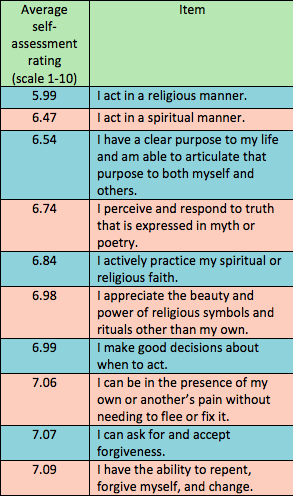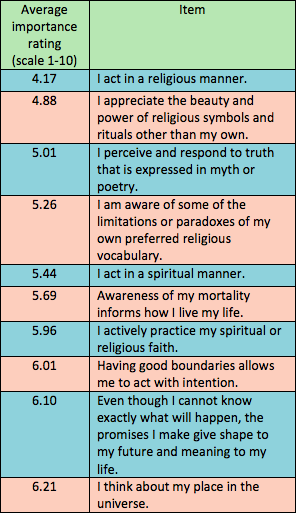|
Spirit Map is unique in the way its algorithm integrates people’s self-assessment and importance ratings to determine Signature Strengths (SS) and Key Opportunities (KO):
We encourage congregations and individuals to consider how their Signature Strengths and Key Opportunities interact with each other, and two pairs from these lists combine in interesting ways:
SS: I believe my life has meaning and purpose. KO: I have a clear purpose to my life and am able to articulate that purpose to both myself and others. SS: I care deeply about the welfare of others. KO: I give to others fully and generously. We regularly see these pairs emerge for the individuals and congregations who complete Spirit Map, and we encourage them to consider how the Signature Strength might support work on the Key Opportunity. For example, in the first pair, the belief that life has meaning and purpose can provide both motivation and a frame for the search for vocation. Daily reflection on what meaning has been found in that day (and where it was not found) can suggest possibilities for a meaningful vocation that connects to a higher purpose. Daily reflection on the meaning found in that day can also strengthen the ability to shift vocation as circumstances change, so that it does not become a static vocation that over time loses its ability to be a vehicle of service to the world’s need or an all-consuming idol out of balance and right relationship. In the second pair, the opportunity is to translate deep caring into personal generosity. Daily reflection on where the care for others might find concrete and generous expression, within good boundaries so that neither the giver nor the recipient becomes burdened, can help both individuals and congregations find the redemptive power of love acting in the world. It’s also interesting to consider what domains of spiritual well-being are reflected in these most-frequent Signature Strengths and Key Opportunities. We’ve done factor analysis on the Spirit Map items to determine which items “bundle” together and found five domains (for more info on this process, see our white paper):
What are the most-frequent Signature Strengths and Key Opportunities in your congregation? Contact us to start the Spirit Map process in your congregation and find out. What are your personal Signature Strengths and Key Opportunities? Take the Spirit Map inventory yourself and see! You can purchase a Spirit Map report, which gives you full access to the inventory, or you can try a sample inventory. Or, explore our website to learn more about us. *We used the data from three Unitarian Universalist congregations, one in Minnesota (n=248), one in Colorado (n=302), and one in Massachusetts (n=133). We only used the data from people in these congregations who gave a self-assessment and an importance rating to all 44 Spirit Map items, hence the n for this analysis (523) is less than the total sample from the three congregations.
0 Comments
We’ve been sharing what we’ve learned about the 768 people who’ve completed the Spirit Map inventory so far (see this post and this post). In this post, we consider what items people identify as least true of them and least important* to them:
One pattern worth noting is how many items on both lists relate to living the spiritual or religious life. Acting in a spiritual or religious manner is less true of and less important in the spiritual lives of the people who have taken Spirit Map so far, despite the fact that most of them belong to a religious community. Their sense that acting in a spiritual or religious manner is less true of them and less important to them seems consistent with the trend that an ever-increasing number of Americans say they have no religious affiliation (currently 22.8% of the US population, according to Pew Research).
If you’re a congregational leader, this could represent an opportunity to reclaim the meaning of the spiritual and religious life by explicitly connecting spiritual and religious practice to what people identify as most true of them (see this post) and most important to them (see this post). This could help renew faith practice by connecting it to what people find particularly relevant for them today. For example, one item that people rate as more true of them and more important to them is “I act with integrity.” To help people connect this statement with their spiritual and religious lives, you might help them consider such questions as:
If you’ve done Spirit Map in your congregation and found this same pattern, you might also want to invite people to explore why they rated those items lower and see what additional insights you can gain from their reflections. What other patterns are you seeing in these lists? What other opportunities do these items present? Leave your reflections in the comments! Sarah Cledwyn of Grow Soul, Spirit Map’s Spiritual Direction Consultant, offers a short practice to reflect on “I act in a religious manner” and its meaning in your own spiritual life: Take a moment to become centered and calm. Perhaps settle into the surface you are sitting on and notice and feel the support it provides you. Now contemplate the phrase, "I act in a religious manner" and see what rises. Without judgement, notice what happens in your body and mind as you sit with this phrase. Simply observe. You may want to journal in a stream of consciousness way about what comes up for you. What do you notice? Are there negative associations? Are there well worn stories that arise? When this exercise feels complete or you have opened some insight for yourself, return to a centered and calm space, again noticing the support of the surface you are sitting on. Now repeat the exercise with this phrase, "I experience faithful devotion to an ultimate reality". Again, without judgement, notice what happens as you slowly sit with this phrase. What happens in your body and your mind? When this feels complete, come back to calm and sit with the phrase, "I am scrupulously and conscientiously faithful". Again notice. When you have sat with and witnessed all three phrases, wonder a little about the reactions that came up for you. Did replacing "religious" with dictionary definitions shift focus for you? Out of these 3 phases, is there one that feels more important and true for you? Why? Where do you find the intersection of what’s true of you and what’s important to you in your spiritual life? Take the Spirit Map inventory yourself and see! You can purchase a Spirit Map report, which gives you full access to the inventory, or you can try a sample inventory. Or, explore our website to learn more about us. *It’s important to note that we ask people to rate the relative importance of the Spirit Map items, which means that when someone says an item is relatively less important it does not mean that item is necessarily unimportant to them. **We have four sources for the data that make up these averages. Three data sets come from three Unitarian Universalist congregations, one in Minnesota (n=248), one in Colorado (n=302), and one in Massachusetts (n=133). The fourth data source is from individuals who have independently taken the Spirit Map survey (n=85). |
What's HereInsights we've gained from Spirit Map. Archives
May 2020
Categories
All
|
|
651-228-1456
|
spiritmap@unityconsulting.org Spirit Map Privacy Policy Spirit Map Terms of Use
|



 RSS Feed
RSS Feed